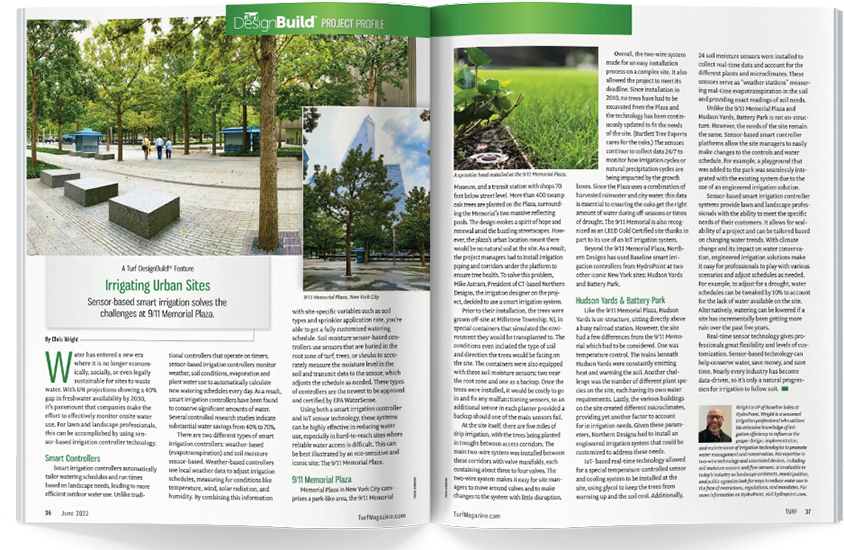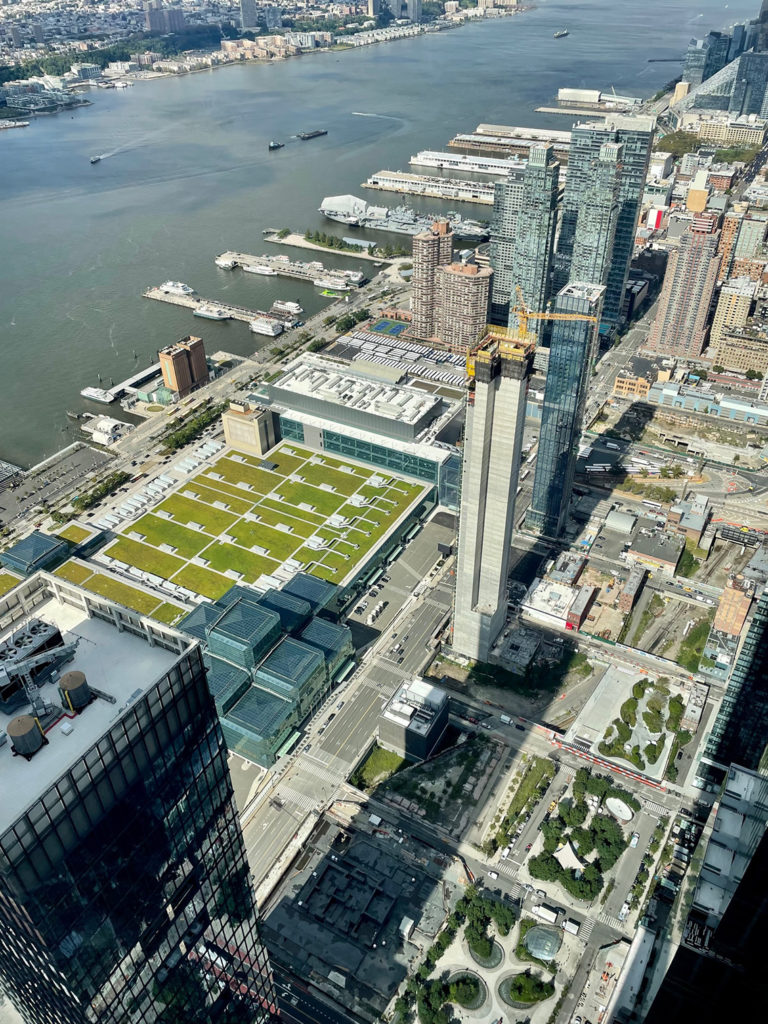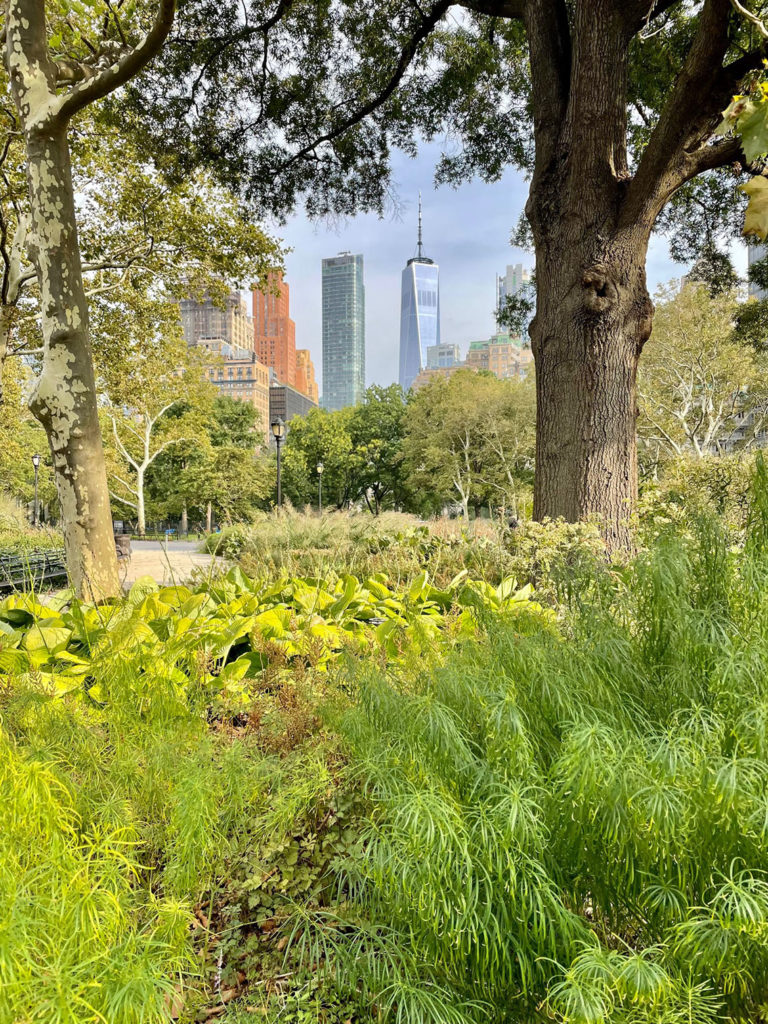Sensor-based Smart Irrigation Solves Urban Landscape Challenges
By Chris Wright, VP of Baseline Sales, HydroPoint

Water has entered a new era where it is no longer economically, socially, or even legally sustainable for sites to waste water. With UN projections showing a 40% gap in freshwater availability by 2030, it’s paramount that companies make the effort to effectively monitor onsite water use. For lawn and landscape professionals, this can be accomplished by using sensor-based irrigation controller technology.
Smart Controllers
Smart irrigation controllers automatically tailor watering schedules and run times based on landscape needs, leading to more efficient outdoor water use. Unlike traditional controllers that operate on timers, sensor-based irrigation controllers monitor weather, soil conditions, evaporation and plant water use to automatically calculate new watering schedules every day. As a result, smart irrigation controllers have been found to conserve significant amounts of water. Several controlled research studies indicate substantial water savings from 40% to 70%.
There are two different types of smart irrigation controllers: weather-based (evapotranspiration) and soil moisture sensor-based. Weather-based controllers use local weather data to adjust irrigation schedules, measuring for conditions like temperature, wind, solar radiation, and humidity. By combining this information with site-specific variables such as soil types and sprinkler application rate, you’re able to get a fully customized watering schedule. Soil moisture sensor-based controllers use sensors that are buried in the root zone of turf, trees, or shrubs to accurately measure the moisture level in the soil and transmit data to the sensor, which adjusts the schedule as needed. These types of controllers are the newest to be approved and certified by EPA WaterSense.
Using both a smart irrigation controller and IoT sensor technology, these systems can be highly effective in reducing water use, especially in hard-to-reach sites where reliable water access is difficult. This can be best illustrated by an eco-friendly and iconic site: The 9/11 Memorial Plaza.
9/11 Plaza
Memorial Plaza in New York City comprises a park-like area, the 9/11 Memorial Museum, and a transit station with shops 70 feet below street level. More than 400 swamp oak trees are planted on the plaza, surrounding the Memorial’s two massive reflecting pools. Its design evokes a spirit of hope and renewal amid the bustling streetscapes. However, the plaza’s urban location meant there would be no natural soil at the site. As a result, the project managers would have to install irrigation piping and corridors under the platform to ensure the health of the trees. To solve this problem, Mike Astram of Northern Designs, the irrigation designer on the project, decided to use a smart irrigation system.

Prior to their installation, the trees were grown off-site in Millstone Township, NJ, in special containers that simulated the environment they would be transplanted to. The conditions even included the type of soil and direction the trees would be facing on the site. The containers were also equipped with three soil moisture sensors: two near the root zone and one as a backup. Once the trees were installed, it would be costly to go in and fix any malfunctioning sensors, so an additional sensor in each planter provided a backup should one of the main sensors fail.
At the site itself, there are five miles of drip irrigation, with the trees being planted in troughs between access corridors. The main two-wire system was installed between these corridors with valve manifolds, each containing about three to four valves. The two-wire system makes it easy for site managers to move around valves and to make changes to the system with little disruption.
Overall, the two-wire system made for an easy installation process on a complex site. It also allowed the project to meet its deadline. Since installation in 2010, no trees have had to be excavated from the plaza and the technology has been continuously updated to fit the needs of the site. (Bartlett Tree Experts cares for the oaks.) The sensors continue to collect data 24/7 to monitor how irrigation cycles or natural precipitation cycles are being impacted by the growth boxes. Since the plaza uses a combination of harvested rainwater and city water, this data is essential in ensuring the oaks get the right amount of water during off-seasons or times of drought. The 9/11 Memorial is also recognized as an LEED Gold Certified site thanks in part to its use of an IoT irrigation system.
Beyond the 9/11 Memorial Plaza, Northern Designs has used Baseline’s smart irrigation controllers at two other iconic New York sites: Hudson Yards and Battery Park.
Hudson Yards

Like the 9/11 Memorial Plaza, Hudson Yards is on-structure, sitting directly above a busy railroad station. However, the site had a few differences from the 9/11 Memorial which had to be considered. One was temperature control. The trains beneath Hudson Yards were constantly emitting heat and warming the soil. Another challenge was the number of different plant species on the site, with each plant having its own water requirements. Lastly, the various buildings on the site created different microclimates, providing yet another factor to account for in irrigation needs. Given these parameters, Northern Designs had to install an engineered irrigation system that could be customized to fit the these needs.
IoT- based real-time technology allowed for a special temperature-controlled sensor and cooling system to be installed at the site, using glycol to keep the trees from warming up and the soil cool. Additionally, 24 soil moisture sensors were installed to collect real-time data and account for the needs of the different plants and microclimates throughout the site. These sensors serve as “weather stations” measuring real-time evapotranspiration in the soil and providing exact readings of soil needs.
Unlike the 9/11 Memorial Plaza and Hudson Yards, Battery Park is not on-structure. However, the needs of the site remain the same. Sensor-based smart controller platforms allow for the site managers to easily make changes to the controls and water schedule. For example, a playground that was added to the park was seamlessly integrated with the existing system due to the use of an engineered irrigation solution.

Sensor-based smart irrigation controller systems provide lawn and landscape professionals with the ability to meet the specific needs of their customers. It allows for scalability of a project and can be tailored based on changing water trends. With climate change and its impact on water conservation, engineered irrigation solutions make it easy for professionals to play with various scenarios and adjust schedules as needed. For example, to adjust for a drought, water schedules can be tweaked by 10% to account for the lack of water available on the site. Alternatively, watering can be lowered if a site has incrementally been getting more rain over the past five years.
Real-time sensor technology gives professionals great flexibility and levels of customization. Sensor-based technology can help conserve water, save money, and save time. Nearly every industry has become data-driven, so it’s only a natural progression for irrigation to follow suit.

Chris Wright, VP of Baseline Sales, HydroPoint
Chris is a seasoned irrigation professional who utilizes his extensive knowledge of irrigation efficiency to influence the proper design, implementation, and maintenance of irrigation technologies to promote water management and conservation. His expertise in two-wire technology and associated devices, including soil moisture sensors and flow sensors, is invaluable in today’s industry as landscape architects, municipalities and public agencies look for ways to reduce water use in the face of restrictions, regulations and mandates.

